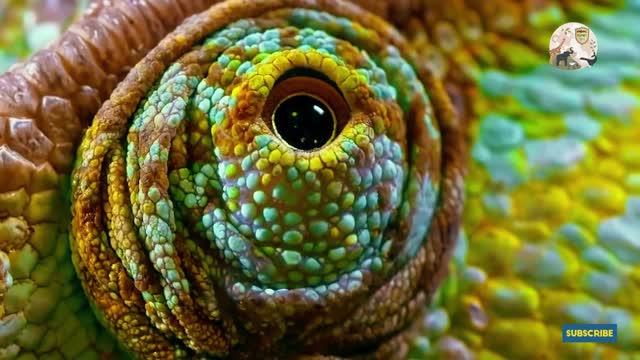Premium Only Content

Chameleon eye Focus on you! Stop
The chameleon is among the most highly visually-oriented lizards, using this sense in prey capture, mating behavior, and predator avoidance. Unique features of chameleon vision include a negative lens, a positive cornea, and monocular focusing. The development of the chameleon visual system could have evolved to aid in prey capture and/or in predator avoidance.
Chameleon eye
The angle, or amplitude, of eye movement in chameleons is very large for a vertebrate and the eyes move independently of each other. This allows a chameleon to watch an approaching object while simultaneously scanning the rest of its environment. Chameleon eyes protrude laterally from the head, giving the lizard panoramic sight. An eyelid fused to the pupil protects the eyes, leaving only a small part exposed. With a negative (nearsighted or concave) lens and a positive (farsighted or convex) cornea, chameleons use a method of monocular focusing to judge distance called corneal accommodation. Each eye focuses independently, which is achieved by the chameleon eye’s unique anatomy of separated nodal and center points of the eye. Finally, “striated rather than smooth ciliary muscle in sauropsids” allows for rapid focusing.
-
 LIVE
LIVE
Canada Strong and Free Network
5 hours agoCanada Strong and Free Network
405 watching -
 44:14
44:14
The Rubin Report
3 hours agoLiberals Saddened as AOC’s Hypocrisy to ‘Fight Oligarchy’ Is Exposed
98.1K39 -
 LIVE
LIVE
Rebel News
1 hour ago $0.80 earnedEzra at Poilievre's rally, Carney's links to China, Libs target legal gun owners | Rebel Roundup
639 watching -
 DVR
DVR
TheAlecLaceShow
3 hours agoGuests: Alex Marlow & Braeden Sorbo | Trump Hits China with 125% Tariffs | The Alec Lace Show
3.38K -
 DVR
DVR
The Tom Renz Show
1 hour agoRFK & MAHA, the House is Doing Something, & Robots for Mars!
5.19K -
 DVR
DVR
Flyover Conservatives
13 hours agoLive Q&A - Nicotine, Health, Vaccines, Natural Detox and Inflammation Reduction - Dr. Bryan Ardis | FOC Show
12.1K3 -
 LIVE
LIVE
LFA TV
16 hours agoLFA TV - ALL DAY LIVE STREAM 4/10/25
2,356 watching -
 DVR
DVR
The Shannon Joy Show
4 hours ago🔥🔥#RealityDC Heats Up - Tariff Whiplash, Pump & Dump Schemes & Scheming Influencers. It’s Freestyle Thursday - Live Q&A Plus Audience Commentary! 🔥🔥
15.2K1 -
 1:01:25
1:01:25
VINCE
5 hours agoTrump Puts China In Their Place w/ Tim Murtaugh | Episode 19 (04/10/25)
272K243 -
 1:23:30
1:23:30
The Big Mig™
6 hours agoBOOM, Trump Signs EO To Investigate The 2020 Election
36.1K5